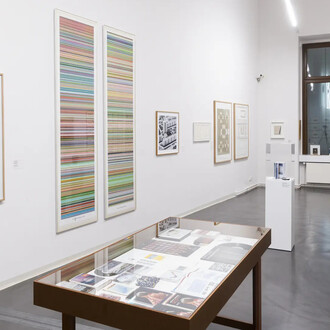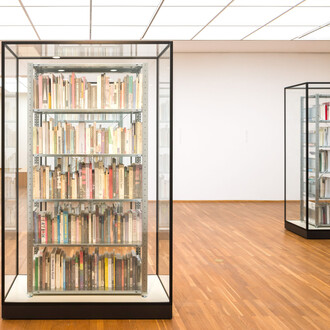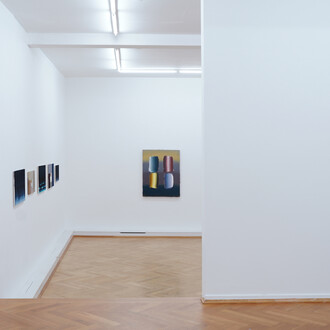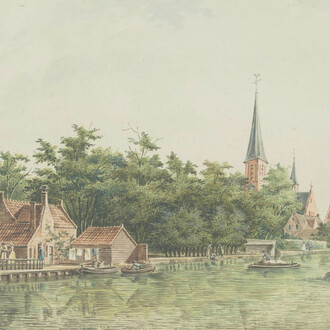Every two to three years, an artist is invited to create a new work for the Museum Ludwig’s largest wall, located in front of the main staircase. Schultze Projects pays homage to artist couple Bernard Schultze and Ursula (Schultze-Bluhm), whose artistic estates are managed by the Museum Ludwig and commemorated with this series, which was initiated in 2017.
For the fourth edition of Schultze Projects, artist Kresiah Mukwazhi (b. 1992 in Harare, Zimbabwe) has created a new mural. Mukwazhi often sources pieces of used clothing or cloth that she sews together and paints to create works that address male violence against women in her home country. She views art as a form of protest and self-empowerment, as well as a starting point for encouraging and supporting women. Mukwazhi understands her artistic practice as visual activism. Her installations, videos, performances, sculptures, and textile collages visualize the experiences of women who face sexualization, discrimination, and marginalization in male-dominated societies. Focusing on the body as the battlefield of structural oppression and abuses of power, she employs used accessories, wigs, and items of clothing, such as petticoats, that are directly or indirectly associated with the female body and socially constructed notions of femininity.
For Cologne, in a departure from her previous, predominantly figurative work, Mukwazhi has created an abstract piece, which at first glance appears to be a vast monochrome. A closer inspection reveals that the work is comprised of innumerous straps and fasteners from thousands of previously worn bras Measuring over thirteen meters long and three meters high, this is the artist’s most ambitious textile piece to date.
Through these materials, exported by industrialized nations as used clothing to African countries, Mukwazhi calls attention to enduring colonial conditions while creating a monumental work that, in the words of the artist, “expresses the power of female collectivity” and aims to “reclaim the sacred nature of women, who should be seen and celebrated as royal beings”. Her observations of gender-based violence and sexual exploitation in Harare’s nightlife, including conversations she conducted with sex workers, are incorporated into the work. Also included are references to African cultures in which women possess an immense spiritual function and a sacred connection to the ground. In these cultures, the ritual act of stripping away one’s clothes carries particular significance, emphasizing the strength and unrelenting resistance of women against all forms of oppression. Mukwazhi’s new work pays tribute to the power of female emancipation, perceived by some as threatening. As the artist explains, “This work tries to regain the power and dignity of women in our society today: the excluded ones, the ones who have rebelled against the oppressive powers of the patriarch and were labeled ‘difficult’ because they decided to raise their voices, as well as the activists, sex workers, artists, outsiders, and women who protest in male-dominated working environments”.
The work’s title, Shanduko nhema, means both “Black revindication” and “Black lies” in Shona, Mukwazhi’s native tongue. The latter can be interpreted as a reference to the racist ideologies used by European powers to substantiate their supposed cultural superiority over non-white people, which cserved as a justification for the colonization of Africa. The artist herself explains: “In the work that I created for Schultze Projects, I challenge the negative notions that are associated with the color black: evil (black magic), darkness, and being an outsider (black sheep)—and I present it as a form of the empowerment of those that it represents”.
Kresiah Mukwazhi most recently presented a significant new work at Art Basel Unlimited 2024. In 2023, she had solo exhibitions at Nottingham Contemporary and the Vienna Secession. In 2022, her works were presented in the Zimbabwe Pavilion at the Venice Biennale.
(Curator: Yilmaz Dziewior)
From 1968 on, Bernard Schultze and his wife Ursula (Schultze-Bluhm) lived and worked as artists in Cologne. For decades they were a fixture of the city’s cultural life and had a particularly close relationship with the Museum Ludwig. The museum now holds a large part of their artistic estate. Bernard Schultze was one of the pioneers of Art Informel in Germany with his works from the early 1950s. The large-scale format was a central aspect of his later work. It represents the substantial reference point for the artists invited to participate in Schultze Projects.
Previous artists:
- Schultze Projects #1 (2017): Wade Guyton.
- Schultze Projects #2 (2019): Avery Singer.
- Schultze Projects #3 (2021): Minerva Cuevas.
















